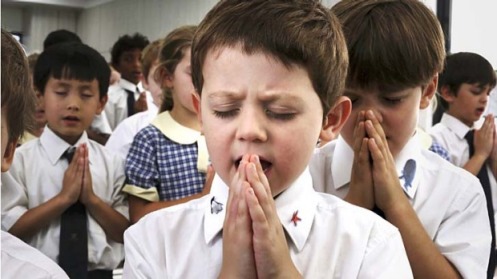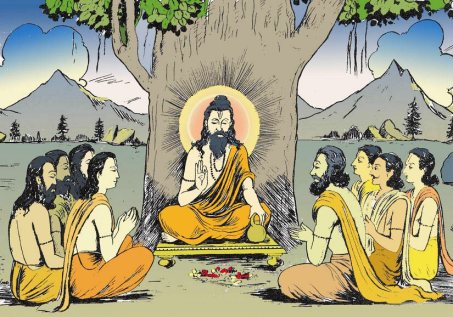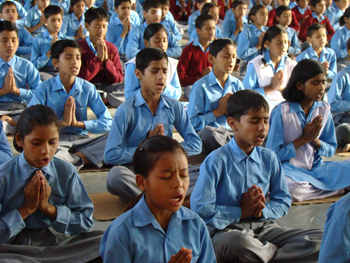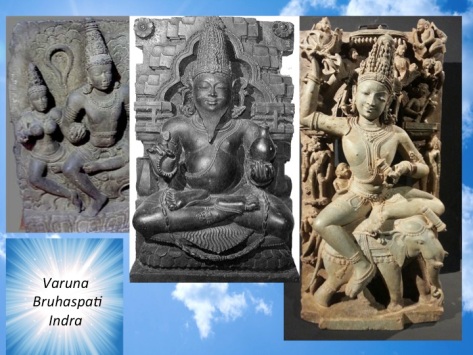 Students praying at school [Source]
Students praying at school [Source]
Knowledge has no doors.
But to enter into the world of knowledge – be it computer programming, dissecting a frog in a biology class, repairing a malfunctioning heart-valve, trying out a new cooking recipe, mixing and pouring concrete to build a road, or pursuing atma vidya, the Knowledge of the Self – I need to open two doors in my mind. The doors of vinayam and sraddha. Then only I can understand, learn and know.
Vinayam is about openness of the mind. An openness born of humility sans arrogance and conceit. Swami Vivekananda says it is the truth in the statement “I do not know”. It is the fertile ground to receive the downpour of knowledge. It is keeping a truly open mind to the magnificent powerful entity that is within me and is also beyond me.
Swami Vivekananda says sraddha is a term that cannot be easily translated into English. It means many things like enthusiasm, sincerity, persistence, perseverance, commitment, all combined.
Knowledge is beyond understanding. My understanding of anything is always tinged with an element of uncertainty. I can never be sure if my understanding will pass the test of time and emerge to be true. In this sense, my understanding of something falls short of knowing it. But the moment I practice my understanding, taste and confirm its truth from personal experience, then any iota of doubt and uncertainty with my understanding goes away. Then I know. For sure. I know the sweetness of sugar from first-hand experience. I can understand a bit about this sweetness from books, hearsay or scholarly lectures, but cannot really know it. One taste, one personal experience is enough to know the sweetness.
Taitriya upanishad siksha valli gives a perspective into the world of knowledge. It is a majestic joining together of the teacher and the student, the rishi declares.
 Vinayam and Sraddha are two pillars of education [Source]
Vinayam and Sraddha are two pillars of education [Source]
The world of knowledge starts at the teacher who has practiced and knows the subject matter. It ends with the student who receives it attentively with sincerity and humility. Knowledge is the harmony joining the teacher and the student. The process of joining is the exposition by the teacher.
athaadhi vidyam | aachaaryah poorva roopam antevaasyutthara roopam| vidyaa sandhih| pravachanm sandhaanam| ityadhi vidyam|| [3.5]
In the vedic educational system, students recite prayers at the beginning and conclusion of classes to understand, learn and imbibe what is taught. These prayers embrace vinayam, sraddha and gratitude. They facilitate the process of knowing.
Students praying at school [Source]
At the beginning of the class, the student says the following prayer.
Images of Varuna, Bruhaspati, Indra. [Source 1] [Source 2] [Source 3] [Source 4]
May Mitra, the effulgence in my outgoing-breath and of the day protect us. May Varuna, the effulgence in my incoming-breath and of the night protect us. May Aryaman, the effulgence in the sun and in vision protect us. May Indra, the effulgence in strength and in hands protect us. May Bruhaspati, the effulgence in speech and in wisdom protect us. May Vishnu, the all pervasive effulgence protect us. I worship Brahman, the effulgence in expansiveness. I worship Vaayu, the effulgence in the wind. You are the cognizable form of Brahman. I worship you as Brahman itself. I worship you as ritam, the operating principle of the universe. I worship you as satyam, Truth.
May that Brahman protect me. May that Brahman protect the teacher.May It protect me. May It protec the teacher.
Aum. Peace. Peace. Peace.
sanno mitras sam varunah | sanno bhavatvaryama | sanna indro bruhaspatih| sanno vishnuh urukramah| namo brahmane| namaste vaayo| tvameva pratyaksham brahmaasi| tvameva pratyaksham brahma vadishyaami| ritam vadishyaami| satyam vadishyaami|
tanmaamavatu | tat vaktaaramavatu| avatu maam| avatu vaktaaram||
Aum Santih Santih Santih ||
At the conclusion of the class, the student recites the prayer again with one important change. In the beginning prayer, the student says “I worship”, “May you protect” etc. In the conlcuding prayer, given below, the student says, “I worshipped”, “You protected” etc . The beginning prayer is worship. The concluding prayer is a statement that the prayer has been fulfilled.
May Mitra, the effulgence in my outgoing-breath and of the day protect us. May Varuna, the effulgence in my incoming-breath and of the night [protect us. May Aryaman, the effulgence in the sun and in vision protect us. May Indra, the effulgence in strength and in hands protect us. May Bruhaspati, the effulgence in speech and in wisdom protect us. May Vishnu, the all pervasive effulgence protect us. I worship Brahman, the effulgence in expansiveness. I worship Vaayu, the effulgence in the wind. You are verily the cognizable form of Brahman. I worshipped you as Brahman itself. I worshipped you as ritam, the operating principle of the universe. I worshipped you as satyam, Truth.
That Brahman protected me. That Brahman protected the teacher. It protected me. It protected the teacher.
Aum. Peace. Peace. Peace.
sanno mitrassam varunah | sanno bhavatvaryama | sanna indro bruhaspatih| sanno vishnuh urukramah| namo brahmane| namaste vaayo| tvameva pratyaksham brahmaasi| tvaameva pratyaksham brahmaavaadisham| ritamavaadisham| satyamavaadisham|
tanmaamaaveet | tat vaktaaramaaeet| aaveenmaam| aaveetvaktaaram||
Aum Santih Santih Santih ||
You can listen to this prayer here.
These two vedic prayers could make the learning process a cinch for students today. Regardless of academic level, language, culture, subject of study, IQ, attentiveness or other parameters, these prayers will benefit students when they recite it wih sincerity and humility.
These two prayers open the doors of vinayam and sraddha in the student’s mind. This allows the knowledge within to shine. Very much like my house getting lit with sunshine the moment I open the door of my house.


